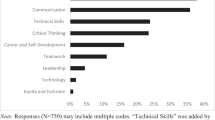Abstract
There are many levels of learning, training, and upskilling within SMEs and these encapsulate varying combinations of formal and informal learning activities. However not all SMEs are proactive in their learning situations and a large proportion of SMEs are in constant ‘crisis management’ mode and therefore need to be encouraged to adopt a learning, training and upskilling environment if they want to survive and prosper. Recent research managed by the Programme for University and Industry Interface at the University of Limerick, Ireland (PUII in Available on line at: http://www.ul.ie/~puii/ (accessed January 21st, 2008)) was charged with identifying key skills and competencies required by individuals in SMEs to ensure their future generation employability. What clearly emerged from this piece of work was the articulation of a range of diverse interventions, which SMEs feel are required to enable them to expand their organizational capacity and the capability of their employees. However, the learning delivery models developed to date for the upskilling of individuals in industry have largely failed to get to the heart of the matter for the SME and are not sufficient to bridge the gap between the needs of the individual in the SME and the needs of the organization. To this end, SME-specific learning delivery models are urgently required to build and create innovative and sustainable learning environments in SMEs, which will simultaneously develop both the individual and the organization. This paper discusses the needs of SMEs in terms of learning and illuminates the need for new innovative programmes which will mark a new step in supporting the delivery on the global priority of educating and upskilling the workforce.
Similar content being viewed by others
References
Barron J., Berger M., Black D. (1999) Do workers pay for on-the-job training. The Journal of Human Resources 34(21): 236–252
CDI. (2008). Innovation by design, Irish companies creating competitive advantage, Centre or Design Innovation, Institute of Technology Sligo. Available on line at: http://www.designinnovation.ie/downloads/Innovationbydesign_2008.pdf (accessed January 4th 2011).
Conti G. (2004) Training Productivity and Wages. The sixteenth annual European Association of Labour Economists (EALE) 2004. Lisbon, Portugal
EGFSN. (2006). Skills at regional level in Ireland, A Study by the Expert Group on Future Skills Needs. Available online at: http://www.forfas.ie/publications/egfsn060525/egfsn060525_regional_skills_report_webopt.pdf (accessed January 24th, 2008).
EGFSN. (2007). Survey of selected multi-national employers’ perceptions of certain graduates from Irish higher education, A Study for the Expert Group on Future Skills Needs, The Higher Education Authority and Forfás. Available on line at: http://www.skillsireland.ie/press/reports/pdf/egfsn071221_quality_of_graduates.pdf (accessed January 24th, 2008).
EGFSN. (2008). Future requirement for high-level ICT skills in the ICT sector. Available online at: http://www.forfas.ie/publications/show/pub298.html (accessed June 25th, 2008).
Enterprise Strategy Group Report. (2004). Ahead of the curve, Ireland’s place in the global economy. Available online at: http://www.forfas.ie/esg/ (accessed January 21st, 2008).
EU report. (2006). A quick guide to EU employment and social policies. Available on line at: http://europa.eu.int/comm/employment_social/social_model/3_en.html (accessed January 21st, 2008).
Fielding, M. (2006). ISME chief executive, ISME press release, december 13th, ISME calls for paid learning leave for small businesses. Available on line at: http://www.isme.ie (accessed January 21st, 2007).
Forfás. (2004). Forfás, Business information system publication, 2004. Available on line at: http://www.forfas.ie (accessed May 7th, 2008).
Holden R., Jameson S., Walmsley A. (2007) New graduate employment within SMEs: Still in the dark. Journal of Small Business and Enterprise Development 14(2): 211–227
Holzer H., Block M., Knott J. (1993) Are training subsidies for firms effective? The Michigan experience. Industrial and Labor Relations Review 46(4): 625–636
Hunt I., Hennessy M., O’Brien E., Sherry R. (2007) The graduate and the SME. Journal of Education, Knowledge & Economy 1(2): 199–210
Hunt, I., Gallagher, M., O’ Sullivan, D., Cosgrave, R., & Swail, K. (2010). ULearning—industry and education, upskilling in Ireland. A report produced by the ULearning Steering Group, http://www.ulearning.ie.
IBEC. (2005). Training and development. IBEC Statement of Policy. Available on line at: http://www.ibec.ie (accessed February 18th, 2011).
IMD. (2005). World competitiveness centre yearbook reports. Available on line at: http://www.imd.ch/research/centers/wcc/index.cfm (accessed January 24th, 2008).
Jaruzelski, B., Dehoff, K., & Bordia, R. (2005). Booz Allen Hamilton global innovation 1000 publication, 2005. Available on line at: http://www.boozallen.com/publications (accessed May 8th, 2008).
Lindquist, K. (2004). Learning region initiatives as a collaborative strategy, EUCEN 27 Conference, University of Limerick, June.
Mc Quade, E. (2005). Bridging the Gap: Employment and employability. Presentation, Available on line at http://www.ul.ie/~puii (accessed January 26th, 2008).
Murphy, S. (2006). Towards a 21st century infrastructure, Chambers Ireland. Available on line at: http://www.chambers.ie/index.php?id=394 (accessed January 21st, 2008).
National Skills Strategy Research Report. (2007). Tomorrow’s skills towards a national skills strategy, expert group on future skills needs. Available on line at: http://www.skillsstrategy.ie/ (accessed July 2008).
O’ Driscoll, E. (2004). Ahead of the curve, Ireland place in global economy. Enterprise Strategy Group, Forfás Publication. Available on line at: http://www.forfas.ie (accessed May 5th, 2008).
O’ Sullivan, D., Rolstadås, A., & Filos, E. (2009). Global education in manufacturing strategy. Journal of Intelligent Manufacturing Systems. doi:10.1007/s10845-009-0326-22010.
Programme for University and Industry Interface. (2005). Moving small companies towards next generation employability. Available on line at: http://www.ul.ie/~puii/ (accessed January 21st, 2008).
Programme for University and Industry Interface. (2006). SME growth through people—the role of higher education. Available on line at: http://www.ul.ie/~puii/ (accessed January 21st, 2008).
Programme for University and Industry Interface. (2007). SME—skills portfolio for the future—supporting SME research. Available on line at: http://www.ul.ie/~puii/ (accessed January 21st, 2008).
Programme for University and Industry Interface (PUII) reports. (2008). Available on line at: http://www.ul.ie/~puii/ (accessed January 21st, 2008).
STI Report. (2006). Strategy for science, technology and innovation 2006–2013; Department of Enterprise Trade and Employment Publication. Available on line at: http://www.deti.ie/science/technology/sciencestrategy.htm (accessed February 18th, 2011).
Author information
Authors and Affiliations
Corresponding author
Rights and permissions
About this article
Cite this article
Hunt, I., Brien, E.O., Tormey, D. et al. Educational programmes for future employability of graduates in SMEs. J Intell Manuf 24, 501–510 (2013). https://doi.org/10.1007/s10845-011-0519-3
Received:
Accepted:
Published:
Issue Date:
DOI: https://doi.org/10.1007/s10845-011-0519-3




